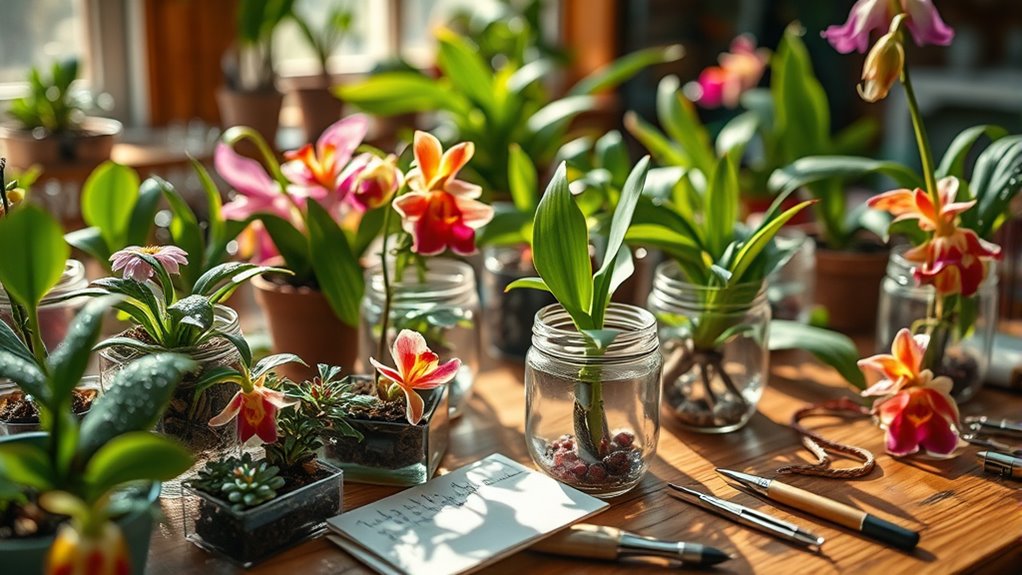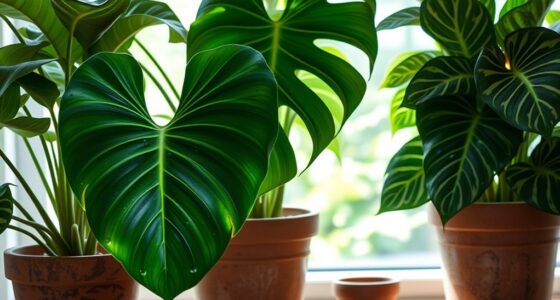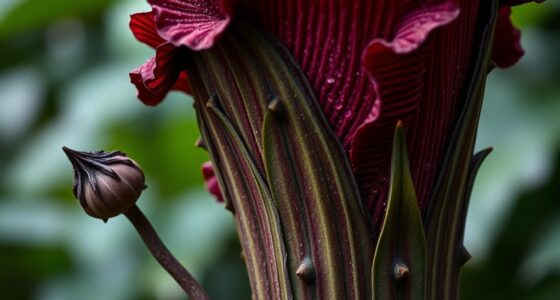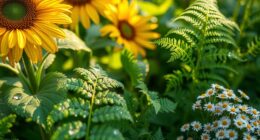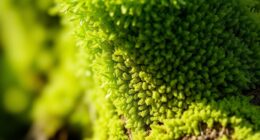To hybridize rare plants at home, start by selecting healthy parent plants and timing your pollination when flowers are fully open and receptive. Use a small brush or toothpick to transfer pollen carefully, then protect your cross from unintended pollination with fine mesh or bags. Consistently provide ideal growing conditions, harvest mature seeds patiently, and nurture seedlings under proper care. If you continue exploring, you’ll discover detailed techniques to create beautiful, unique cultivars from your garden.
Key Takeaways
- Master hand pollination techniques and timing to ensure successful fertilization of rare plants at home.
- Maintain optimal growing conditions, including proper light, water, and soil, to support seed development.
- Protect flowers from unintended pollination with bags or mesh to control parentage and preserve hybrid traits.
- Label each cross carefully to track parent plants and desired characteristics for future cultivation.
- Be patient and consistent, as seed maturity and hybrid success require time, practice, and proper nurturing.
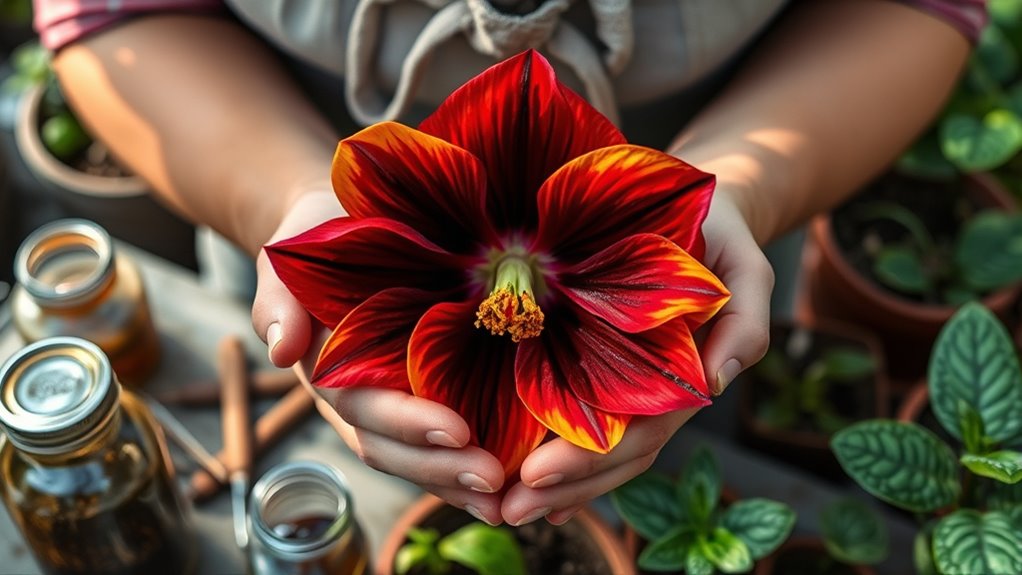
Hybridization at home has become an exciting and accessible way to experiment with plants and improve your garden. By crossing different plants, you can create unique cultivars that bring new colors, flavors, and traits. To succeed, you need to understand the basics of pollination techniques and verify ideal growing conditions. These elements are essential for producing viable seeds and healthy seedlings.
First, you should familiarize yourself with pollination techniques. Hand pollination is the most common method for home hybridization, especially when working with rare or delicate plants. It involves transferring pollen from the flower of one plant to the stigma of another using a small brush, toothpick, or even your fingers. Timing is critical; you’ll want to pollinate when the flowers are receptive, usually when petals are fully open and the stigma looks sticky. For best results, do this in the morning when flowers are most receptive and pollen is fresh. Label each cross carefully so you can track your hybrids and understand which traits come from each parent.
Growing conditions play an essential role in successful hybridization. You need to create an environment that supports healthy flowering and seed production. This means providing adequate light—most flowering plants require full sun or bright indirect light—along with proper water, temperature, and soil conditions. For example, if you’re working with fruiting plants, maintaining consistent moisture and avoiding stress helps verify good pollination and seed set. Also, consider the plant’s specific needs; some plants thrive in acidic soil, while others prefer alkaline. By adjusting your growing conditions to suit each plant, you improve the chances of successful hybridization and strong seed development. Additionally, understanding Gold IRA regulations and best practices can help you safeguard your investments if you decide to diversify your garden with valuable or rare plant varieties.
Once you’ve pollinated your plants, it’s necessary to protect the flowers from unintended pollination by insects or wind. Covering the flowers with fine mesh or bags prevents contamination and guarantees that only your selected pollen fertilizes the ovules. After fertilization, patience is key. Seeds will develop over weeks or months, depending on the species. When they’re mature, harvest them carefully and plant them in suitable growing conditions, providing the same attention you gave the parent plants.
Hybridization at home gives you the power to create new, exciting plant varieties. By mastering pollination techniques and understanding your plants’ growing conditions, you’ll increase your success rate and enjoy the thrill of developing rare and beautiful cultivars. With patience and practice, your garden can become a living laboratory where innovation and beauty thrive hand in hand.
Frequently Asked Questions
What Are the Best Tools for At-Home Plant Hybridization?
For at-home plant hybridization, you’ll need essential tools like fine-tipped brushes or toothpicks for pollination techniques, allowing precise transfer of pollen. A sterile workspace, such as a clean surface or small greenhouse, helps prevent contamination. You should also have small scissors or tweezers for flower manipulation and labels to track your crosses. These tools make hybridization easier and more successful, giving you better control over creating new cultivars.
How Do I Prevent Cross-Contamination Between Different Plant Species?
Imagine your plants as characters in a delicate dance, each step carefully planned. To prevent cross-contamination, you should use sterile techniques like sterilizing tools and gloves, and isolate different species with physical barriers or separate containers. These isolation methods keep your plants’ genetics pure, ensuring successful hybridization without unintended crossbreeding. Stay vigilant and methodical, and you’ll safeguard your unique cultivars and nurture healthy, distinct plant varieties.
Can Hybrid Plants Be Propagated Through Seeds Only?
Hybrid plants can often be propagated through seed propagation, but success varies depending on the species. When you grow hybrid seeds, you preserve genetic diversity, which can lead to new and unique cultivars. Keep in mind, some hybrids may not come true to seed, so you might need to experiment or use other propagation methods like cuttings for consistent results. Seeds offer a simple way to expand your hybrid collection naturally.
What Are Common Mistakes to Avoid in Home Hybridization?
When hybridizing plants at home, you should avoid common mistakes like rushing pollination timing, which can lead to unsuccessful crosses. Make sure to control pollination carefully and document your process. Also, don’t forget to maintain genetic diversity by selecting varied parent plants; this improves the chances of creating healthy, resilient cultivars. Patience and attention to detail are key to successful hybridization and developing unique, thriving new plants.
How Long Does It Typically Take to See Results From Hybridization?
When you hybridize plants at home, the timeline expectations for seeing results vary, typically taking several months to years. You need patience as genetic expression can be unpredictable, and some plants may take longer to show desirable traits. Keep in mind that initial seedling growth doesn’t guarantee the final cultivar, so monitor progress regularly and understand that consistent care influences how quickly you observe new characteristics.
Conclusion
By hybridizing plants at home, you open endless possibilities for creating unique cultivars. Did you know that over 80% of the popular garden flowers today are the result of hybridization? This shows how your small efforts can lead to big, beautiful innovations in your garden. So go ahead, experiment with different plants, and watch as your personal touch transforms your home garden into a vibrant, one-of-a-kind paradise.

